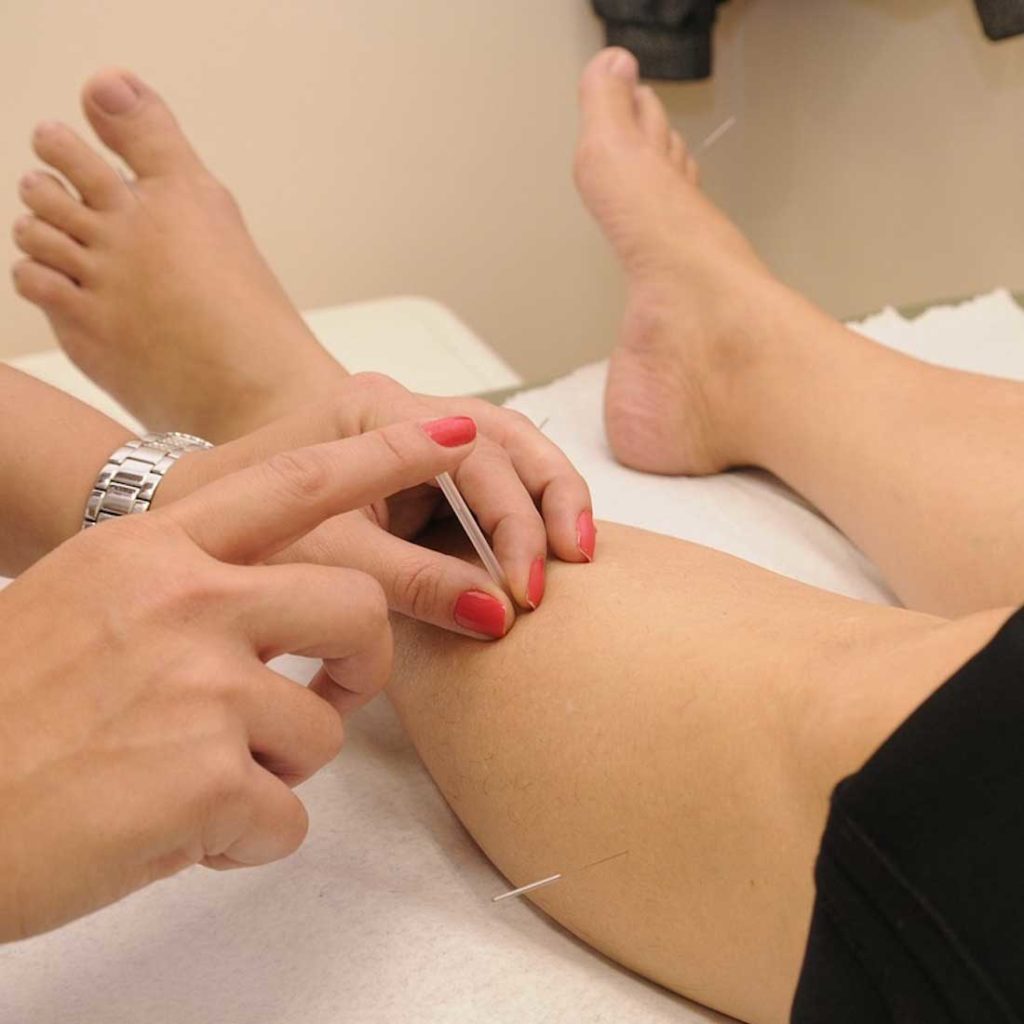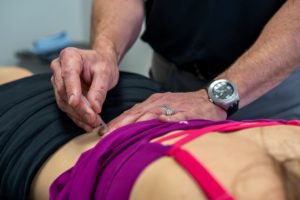What is IMS?
Intramuscular Stimulation (IMS) is a specialized and effective physiotherapy treatment designed to alleviate chronic pain and muscle tightness. It targets specific muscles or trigger points that contribute to your discomfort by using fine, sterile acupuncture needles.
The primary aim of IMS is to stimulate a healing response within the affected muscles, release tension, and enhance nerve function. This technique encourages the body’s natural healing mechanisms and helps to restore optimal muscle performance.
If you’re struggling with persistent pain or muscle stiffness that hasn’t improved with other treatments, IMS might be a suitable option for you.
The Origin of Intramuscular Stimulation (IMS)
Intramuscular Stimulation is often synonymous with Gunn IMS, after Dr. Chan Gunn who innovated it while working for the BC Worker’s Compensation Board in the 1970s. Dr. Chan Gunn was working in Vancouver when he made his groundbreaking discovery.
Dr. Gunn encountered many patients who suffered from chronic pain which refused to go away even though the patients were not suffering from any major injuries like broken bones or damaged tendons.
Although Dr. Gunn was trained in Western medicine, he also studied and had a sound knowledge base in Chinese Acupuncture. He deduced that most of the chronic pain in his patients was a result of the nerves overstimulating the muscles.
Dr. Gunn referred to this as neuropathic pain and thought that the pain would reduce if he ‘re-booted’ the nervous impulses feeding the muscles. In order to achieve this ‘re-boot’, he used Acupuncture needles to stimulate the affected muscles.
It has now been several decades since Dr. Gunn had his eureka moment, and Intramuscular Stimulation has gained a lot of traction. He, along with other researchers, conducted extensive studies to perfect the practice. Dr. Gunn also developed a curriculum for training medical professionals, like Physiotherapists, in administering Intramuscular Stimulation. Today, his program is taught at the University of British Columbia’s School of Medicine.
Dr. Gunn is now a clinical professor teaching IMS at the Washington Multidisciplinary Pain Center at the University of Washington. He still has a practice in Vancouver and started the Physical Medicine Research Foundation as well as the Institute for the Study and Treatment of Pain.

Dr. Gunn has won many awards, including the Order of British Columbia and the Order of Canada, which is the highest national order.
How Intramuscular Stimulation Works
The IMS-trained Physiotherapist will first perform a specialized assessment to determine if the patient is an appropriate candidate for IMS treatment. Special autonomic nervous system tests, palpation, and movement screen are important in this assessment.
During IMS treatment, the Physiotherapist will use needles that are very similar to traditional Acupuncture needles. The Physiotherapist will sterilize the area, insert the needle into the affected tight muscle and manipulate the needle as needed – gradually changing the depth and direction causing the patient to feel a twitch or a cramp in the muscle. Once achieved, the needle is removed from that muscle.
Twitching happens when the muscle quickly contracts and then relaxes. Cramping happens when the muscle slowly contracts and then relaxes more slowly. These twitching and cramping reactions are signs that the muscle is not functioning normally. Normal muscles don’t feel a thing. This insertion of needles can also be referred to as Dry Needling.
Muscles react like this, contracting and relaxing, because of the stretch reflex. The stretch reflex is a sensory mechanism within the muscles that determines the length and tension of the muscle. When the stretch receptors are stimulated, the muscles will always be contracted to some degree.
This makes the muscles feel tight all the time – some patients describe these muscles as “ropey”, “stiff”, or “taut”, which is a hallmark sign of a dysfunctional muscle that may be suitable for IMS treatment. The purpose of IMS is to normalize this stretch reflex and reset the ideal length-tension in the muscle.
Intramuscular Stimulation was developed as a remedy for chronic muscle pain and tension that results from muscles held in a consistently tight/shortened state (> 6 weeks). The pain in these muscles can go away for a brief moment but it often returns when you try to stretch or contract them again. If this sounds like what you are experiencing, then you might want to consult one of our Physiotherapists about Intramuscular Stimulation.

Besides affecting the stretch reflex, nerve input, and muscle itself, when the needle is inserted into the muscle, it creates a tiny wound that encourages blood to flow into the area of the muscle which stimulates healing.
The longer a muscle has been tight, the lower the circulation and healthy tissue levels will be in that area. IMS treatment will stimulate fresh blood cells to the area and create a healthy inflammatory response to carry away any excess toxins in the affected muscle tissues.
Patients will see benefits within 6-10 IMS treatment sessions. Each session is cumulative, building upon the last one. People whose condition is more severe may need to undergo more sessions than others. If your pain has been going on for longer, you will also need more sessions.
Due to the internal effects on your body and muscles treated by IMS, we recommend a one week break in between sessions to aid the body in healing and adapting to the positive effects of IMS.
IMS Treatment vs. Acupuncture
Some patients may wonder what exactly separates Acupuncture from IMS. Well, first of all, IMS was developed just a few decades ago while Acupuncture has been practiced for centuries. The tools (needles) used are the same in both cases, however, in Acupuncture, needles are usually retained in the body for a longer period of time than IMS treatment.
Acupuncture also follows a thorough traditional Chinese medicine assessment and treatment plan that helps patients looking for relief from everything from anxiety to digestive problems to muscle pain. The points chosen in Acupuncture follow the meridians of energy as studied in Traditional Chinese Medicine.
As mentioned earlier, Dr. Gunn applied his knowledge of conventional medicine with Acupuncture for the sake of his chronic pain patients. In turn, IMS is a good combination of Western conventional medicine and Eastern traditional medicine and is primarily designed to treat chronic pain and muscle tension.
Patients who still suffer pain even after going through normal Physiotherapy should consider IMS treatment.
The Benefits of IMS Therapy
The most important application of IMS is in the treatment of musculoskeletal pain and neuropathic pain, predominantly in a chronic state (> 6 weeks). Patients who present with lower back pain, tennis elbow, carpal tunnel, chronic whiplash, sciatica, or fibromyalgia probably stand to benefit the most from IMS.
The list of ailments that can be treated using IMS is long. Conditions that will benefit from IMS Treatment include (but are not limited to):
- Achilles Tendonitis
- Golfers and Tennis Elbow
- Jaw and TMJ Pain
- Carpal Tunnel Syndrome
- Shoulder and Hip impingement syndromes
- Myofascial Pain Syndrome
- Chronic postural pain
- Iliotibial Band Syndrome
- Headaches
- Neck Pain
- Patello-femoral Syndrome
- Chronic Tendonitis or Bursitis
- Low Back Pain
- Repetitive Strain Injuries
- Shin Splints
- Sciatica
- Trigger Finger
- Torticollis
- Spinal Disc Problems
- Plantar Fasciitis
- Piriformis Syndrome
NOTE: Because IMS was developed to deal with chronic musculoskeletal pain, it will not work for chronic inflammatory pain or other forms of pain. Patients who are experiencing pain as a result of cancer, arthritis, Diabetes, or Parkinson’s disease may not experience the benefits. Pregnant women and people who are recovering from surgeries and infections are not advised to do IMS.
Does IMS Hurt?
Patients who have already undergone Acupuncture before will find IMS relatively more painful compared to Acupuncture. This is often due to the direct insertion of the needle into the affected and painful muscle.
It is more unpleasant because the intention of needling the muscles is to stimulate them – to trigger a reaction at the nerve and in turn reset the nervous system response at that muscle. When a normal muscle is pierced by a needle, it does not respond the same way that a contracted or hyper-active muscle will react. It often feels little to no pain at all. This is why an IMS-trained Physiotherapist needs to complete a thorough assessment before initiating IMS treatment.
IMS relies on an experienced understanding of the human body’s anatomy as well as using medical examinations to select the appropriate needle points for each unique patient. It is an ancient tool, used better with the application of modern scientific knowledge. Our Physiotherapists are highly trained to use an IMS technique that is effective and relatively comfortable to receive.
Are There Any Side Effects of IMS?
It is normal to feel soreness or achiness in the area that was treated during the first 24-48 hours after treatment. Due to the increased blood flow and twitch response of the muscles during treatment, these areas are temporarily weakened. We recommend no vigorous exercise or stress on the body so that the positive effects of IMS can take place during this time. After this time, the soreness should be gone and you will not feel any additional discomfort. Normal functionality will resume.
Other than this, common side effects include bruising and local tenderness at the area of treatment.
To help relieve soreness, we recommend all of our patients to drink a lot of water and to use heat over the affected areas to flush the body and aid in healing (e.g. warm bath, warm compress).

If you think you might benefit from IMS, it is a good idea to talk to one of our Physiotherapists about it. We are always happy to consult on your health and help you get back to the things you love to do, pain-free!
Click here to see our team of IMS-trained Physiotherapists or book now!






Have you met our IMS Specialists?
Our friendly and professional physiotherapists possess advanced expertise in Intramuscular Stimulation (IMS).

